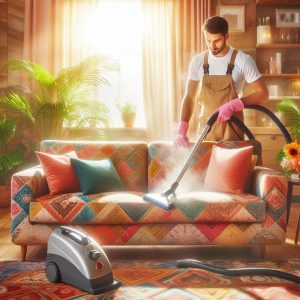 When cleaning your upholstered furniture, focus on stain removers, steam cleaners, or which products smell the nicest. But did you know that pH is one of the most critical factors in how well your upholstery gets cleaned? That’s right—something as small as the pH level of your cleaner can make a big difference in how effective it is. For best results, consider using a recommended upholstery cleaning service that understands the science behind the cleaning.
When cleaning your upholstered furniture, focus on stain removers, steam cleaners, or which products smell the nicest. But did you know that pH is one of the most critical factors in how well your upholstery gets cleaned? That’s right—something as small as the pH level of your cleaner can make a big difference in how effective it is. For best results, consider using a recommended upholstery cleaning service that understands the science behind the cleaning.
Let’s explain why pH matters and explore how it affects furniture, stains, and cleaning results.
What Is pH, Anyway?
pH stands for “potential of hydrogen.” It’s a scale that tells us how acidic or alkaline (or basic) a substance is. The pH scale runs from 0 to 14:
- 0–6 = Acidic
- 7 = Neutral (like pure water)
- 8–14 = Alkaline
Most cleaners fall somewhere on this spectrum, and knowing where can help you pick the right one for your upholstery.
Acidic vs. Alkaline: What’s the Difference?
Think of acidic and alkaline cleaners like different tools in a toolbox. You wouldn’t use a hammer to tighten a screw. The same idea applies here—different pH levels are better for various stains and surfaces.
Acidic Cleaners (pH below 7)
Acidic cleaners remove mineral-based stains like rust, calcium, and hard water deposits. They work by breaking down the mineral bonds, making the stains easier to remove.
In upholstery cleaning, mildly acidic solutions (pH 4-6) are often used as rinses or fabric conditioners. They help neutralize leftover alkaline cleaner residue and restore the fabric’s natural feel. Some are also used to tackle organic stains, like coffee or wine.
Pros:
- Good for neutralizing alkaline residues
- Gentle on delicate fabrics
- Helps brighten and refresh fabrics
Cons:
- Not great at cutting through greasy or oily stains
- Can be too harsh if too acidic
Alkaline Cleaners (pH above 7)
Alkaline cleaners are the heavy lifters. They’re great at breaking down grease, oils, food stains, and body oils—all common culprits in upholstered furniture. These cleaners work by loosening up the fats and proteins in grime so they can be rinsed away easily.
Most general-purpose upholstery cleaning solutions have a pH range of 9 to 11. They’re strong enough to lift dirt but (usually) gentle enough not to damage the fabric if used correctly.
Pros:
- Excellent at dissolving grease, grime, and dirt
- Effective for most household upholstery stains
- Leaves furniture feeling clean and refreshed
Cons:
- It can leave behind a residue if not rinsed properly
- It may cause fabric discoloration or fading over time
Matching pH with Fabric Type
Not all upholstery fabrics are created equal. Some are tougher (like synthetic fibers), while others are more delicate (like silk, wool, or cotton blends). Using a cleaner with the wrong pH can damage the fabric or shorten its life.
- Delicate fabrics like wool or silk: Use mildly acidic or neutral pH cleaners (around pH 5–7)
- Synthetic fabrics like polyester, nylon, or microfiber Can typically handle mildly alkaline cleaners (pH 8–10)
- Heavily soiled or greasy furniture: May benefit from a stronger alkaline cleaner (pH 10–11), but test first
Always spot-test your cleaner on a hidden area of your upholstery before using it across the whole surface.
Why pH Balance Matters for Cleaning Efficiency
The effectiveness of a cleaner isn’t just about its strength. It’s about how well its chemistry matches the type of stain and fabric.
A high-pH (alkaline) cleaner might be great for greasy pizza stains on a polyester couch but completely overkill for a light coffee stain on a cotton armchair. Worse, it might leave a residue that attracts more dirt later.
That’s why professional upholstery cleaners often adjust the pH during a cleaning process—starting with a higher-pH solution to break down the grime and followed by a lower-pH rinse to neutralize and condition the fabric.
This balance helps:
- Prevent residue buildup
- Protect fabric texture and color
- Improve long-term cleanliness
Next time you shop for an upholstery cleaner or tackle a tricky stain, peek at the label and check the pH. It may not seem like a big deal, but understanding pH can mean the difference between a so-so-clean and a deep, fabric-friendly refresh.